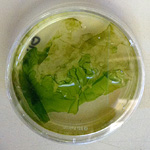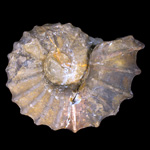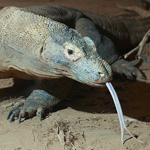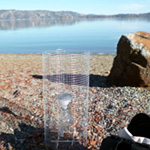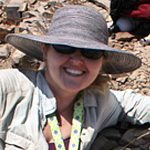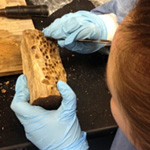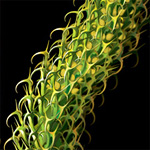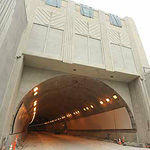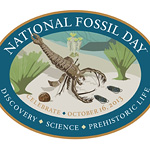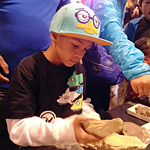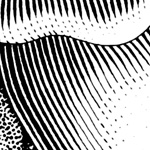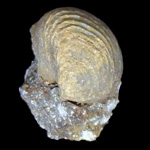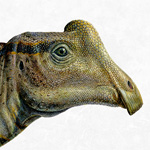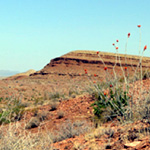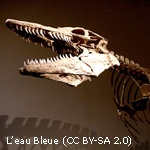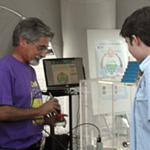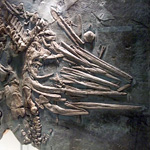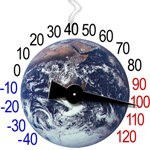Ninety-six percent of marine and 70% of terrestrial species died in the Permian mass extinction, which began about 252 million years ago and lasted for over 20,000 years. Geochemistry tells us that this extinction coincided with a severe and rapid change in the Earth’s carbon cycle, but this alone could not have been the cause of the extinction. Initially it was thought that carbon dioxide released by Siberian volcanism explained this change in the carbon cycle but the volcanic outgassing was … [Read more...] about Mighty microbes implicated in Permian mass extinction
Latest News
Tracking down ammonites in the Denver, Colorado, area
In July 2013, I visited the Denver, Colorado, area to collect data from two collections housed at United States Geological Survey (USGS) facilities and the University of Colorado (CU) Museum of Natural History. The USGS collections are housed in the Core Research Center on the Denver Federal Center campus. The building is also a repository for a large collection of soil samples and approximately 1.7 million feet of drilled rock, sediment, and ice cores. The Museum of Natural History is … [Read more...] about Tracking down ammonites in the Denver, Colorado, area
Examining morphologic variation in varanid skulls through time and space
As a graduate student affiliated with the UCMP, there are many resources readily available to me. Not only does the museum have the largest university research collection, but the curators, museum scientists, and staff are some of the most knowledgeable and helpful anywhere. UCMP is recognized for taking care of its graduate students, and one of the ways they do it is by providing multiple funding opportunities. I applied to UCMP for funding last year in order to conduct museum travel for my … [Read more...] about Examining morphologic variation in varanid skulls through time and space
California pollen taphonomy and pollen trap study in Clear Lake, California
Pollen analysis (or palynology) has been used to study Quaternary changes in vegetation and climate in North America since the nineteenth century. Palynologists generally compare plant assemblages in spatial-time frames instead of focusing on particular plant species. These changes in plant assemblages across landscapes through time are a good indication of vegetation shifts caused by environmental changes. Besides using pollen assemblages to reconstruct parent plant communities in a particular … [Read more...] about California pollen taphonomy and pollen trap study in Clear Lake, California
The hunt for a Ph.D. thesis: Collecting Late Cretaceous plant fossils in New Mexico
"It ain't Mexico and it ain't new" [quoted from a postcard in a gift shop] Armed with hammers, chisels, pry-bars, boxes of newspaper, and sunscreen, two trusty assistants (recent graduate Meriel Melendrez and current undergrad Nicolas Locatelli) and I drove from Berkeley in our 4WD extra-long SUV heading for southern New Mexico. There, we met up with paleobotanist Dr. Gary Upchurch and crew from Texas State University and geologist Dr. Greg Mack from New Mexico State University for two weeks of … [Read more...] about The hunt for a Ph.D. thesis: Collecting Late Cretaceous plant fossils in New Mexico
Waterlogged wood on the seafloor and the critters that call it home
For a marine biologist, I spend a lot of time thinking about wood. What happens to it if it happens to wash into a stream? How much of it gets into the ocean? Where does it sink? What happens to it once it reaches the bottom? What animals are likely to make it their home? I’m far from the first to think about the role of wood in ocean systems. In fact, Darwin thought quite a bit about how plant material might make its way into the ocean and how long different kinds of wood might stay afloat … [Read more...] about Waterlogged wood on the seafloor and the critters that call it home
Grad student’s artwork graces journal cover
“There are great color reconstructions of dinosaurs, so why not a plant?” thought Department of Integrative Biology and UCMP grad student Jeff Benca when he set out to reconstruct the appearance of a 375-million-year-old Devonian plant. Using Adobe Illustrator CS6 software, he constructed a striking three-dimensional, full-color portrait of a stem of the lycopod Leclercqia scolopendra, or centipede clubmoss. This was no small feat, considering that the fossil plant Jeff was illustrating was a … [Read more...] about Grad student’s artwork graces journal cover
Following The Graduates on KALX Berkeley
UCMP and Department of Integrative Biology graduate student Tesla Monson, a second-year graduate student in the Hlusko Lab, is the host of a new talk show, The Graduates, on KALX Berkeley, kalx.berkeley.edu! KALX is a UC Berkeley and listener-supported independent radio station and an ideal platform for The Graduates, a show featuring Tesla interviewing UCB graduate students about their research. Debuting on Tuesday, April 8, at 9:00am, The Graduates will air every other Tuesday, from 9:00 am … [Read more...] about Following The Graduates on KALX Berkeley
The geology and paleontology of the Caldecott Tunnel’s Fourth Bore
The fourth bore of the Caldecott Tunnel opened to traffic on November 16, 2013, and if you're an East Bay resident, chances are good that you've been through it once or twice (at least!). Did you realize that each time you drive through the tunnel you're passing through several million years of accumulated sediment that has been pushed up on its side? Want to know more about the rocks the tunnel cuts through and the fossils found in them? As part of an agreement between UCMP and the California … [Read more...] about The geology and paleontology of the Caldecott Tunnel’s Fourth Bore
Erica, PaleoPortal, and the National Fossil Day connection
Before coming to UCMP, Erica Clites — currently working on an NSF-funded project to rehouse and digitally image the orphaned USGS Menlo Park invertebrate collection out at the Regatta facility in Richmond — spent about two and a half years with the National Park Service. In 2010 she coordinated a nationwide outreach effort for the first NPS-sponsored National Fossil Day, which was held on October 16th this year. Read an interview with Erica about her work with the NPS on the Park … [Read more...] about Erica, PaleoPortal, and the National Fossil Day connection
Who lived here before the Giants?
For the third consecutive year, UCMP participated in the Bay Area Science Festival at AT&T Park as one of several Science@Cal exhibitors. The November 2, 2013, festival drew more than 28,000 science fans and Lisa White, Tripti Bhattacharya, and volunteer CJ Dunford staffed a UCMP table. With a theme of "Who lived here before the Giants?," the UCMP fossil display and activities were a big hit with the little fans! … [Read more...] about Who lived here before the Giants?
The 2014 UCMP Fossil Treasures Calendar is now available
Examples of the scientific illustrator's art Early this past year, as UCMP continued its efforts to catalog the museum's archival collections, a small collection of original scientific illustrations were rediscovered. These pieces represent the work of a number of talented scientific illustrators who produced images for the publications of UCMP curators, staff, and students between the years 1934 and 1991. All who saw these works were impressed by the skill, patience, and steady hand required … [Read more...] about The 2014 UCMP Fossil Treasures Calendar is now available
Encounters in the field: UCMP and the US Geological Survey
Hundreds of specimens from the former USGS Menlo Park Collection, now housed in the UC Museum of Paleontology, were collected in the pioneering days of geological and paleontological exploration of California. This includes fossils collected by Charles A. White, Timothy W. Stanton, Joseph S. Diller and other legendary figures at the US Geological Survey. The newly founded Department of Paleontology at UC Berkeley also led numerous expeditions and excavations of vertebrates in California in the … [Read more...] about Encounters in the field: UCMP and the US Geological Survey
Werning co-authors paper on growth in Parasaurolophus
Recent Ph.D. grad Sarah Werning, now in a postdoctoral position at the State University of New York at Stony Brook, was a major contributor to a paper released today on ontogeny in Parasaurolophus, a Cretaceous hadrosaurid dinosaur notable for the hollow, bony tube on its skull. The study centers around a remarkable skeleton of a baby Parasaurolophus (nicknamed "Joe") discovered in 2009 by Kevin Terris, a student at The Webb Schools in Claremont, California, in exposures of the … [Read more...] about Werning co-authors paper on growth in Parasaurolophus
UCMP hosts phylogenies and fossils workshop
On September 23-25, 2013, the UCMP hosted a workshop on Integrating Molecular Phylogenies and the Fossil Record supported by the France-Berkeley Fund. Led by UCMP Director Charles Marshall and Hélène Morlon from École Polytechnique in France, the workshop brought together leading researchers who are developing methods for inferring diversity dynamics using molecular phylogenies or fossil data. The gathering of approximately 25 people included UC Berkeley faculty and UCMP graduate students and … [Read more...] about UCMP hosts phylogenies and fossils workshop
A trip to New Mexico
Why New Mexico? Like someone else put it "it ain't new and it sure ain't Mexico!" So why make the trek? To attend the Carboniferous-Permian Transition Meeting! Five members of the Looy Lab piled into a van and drove all the way from Berkeley to Albuquerque. With the enormous number of meetings and conferences being organized, why did we decide to go to this particular one? I think there is a checklist that most people go over before they decide on which conference to attend. In random … [Read more...] about A trip to New Mexico
A whale of a find
The upper Miocene-Pliocene Purisima Formation near Capitola, California, is well known among avid fossil collectors and popular with beachcombers. While this seaside shallow marine deposit contains rich assemblages of clams, snails and other invertebrates, fossil vertebrates such as whales, fishes, and birds are the most prized. Happily this is a case in which amateurs and scientists have often partnered to exchange fossils and report findings. Fossil hunters Frank Perry, Stan Jarocki, and … [Read more...] about A whale of a find
Understanding Science is now in Portuguese
Você fala português? If so, you’ll be pleased to learn about Understanding Science’s new Portuguese translation, led by Unversidade de Lisboa Principal Researcher Nuno P. Barradas and his team. Nuno and colleagues recently promoted Understanding Science in Portuguese at a community science event in the town of Estremoz, east of Lisbon. Science on the Streets was organized by Portugal’s national agency for public awareness of science, Ciência Viva ("Living Science"), and the Understanding … [Read more...] about Understanding Science is now in Portuguese
Cataloging the archives: Paleontology specimen exchange
How do natural history museums build their collections? The UCMP's fossil collection is largely a product of decades of field work by past and present researchers. As the State's fossil repository, the museum also receives a large number of fossil finds from construction sites in California (for example, the Caldecott Tunnel). Another, perhaps less appreciated means of acquiring scientifically valuable specimens, is specimen exchange between institutions — it's a bit like a holiday gift exchange … [Read more...] about Cataloging the archives: Paleontology specimen exchange
Barnosky interviewed about climate change
Tony Barnosky, UCMP Curator and Professor of Integrative Biology, discussed a consensus statement to world leaders regarding global change, Maintaining Humanity's Life Support Systems in the 21st Century, this past week in an interview by KQED Science Editor Craig Miller. Barnosky has been working with the California Office of the Governor to promote science-based solutions to global change problems. With 15 other global change scientists he developed the scientific consensus statement, which … [Read more...] about Barnosky interviewed about climate change
